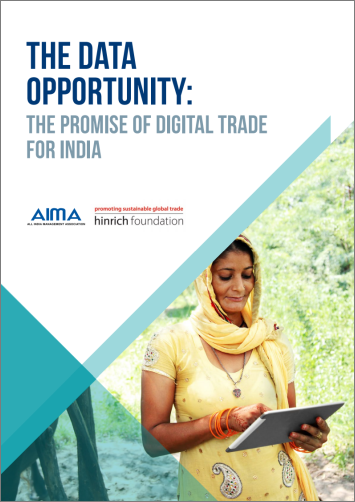Digital trade
India’s digital trade sector to grow 14-fold to US$512 billion by 2030
Published 25 July 2019 | 4 minute read
The flow of digital goods and services globally have surged and exerted greater upward pressure on productivity and growth. As highlighted in the Hinrich Foundation India Digital Trade Report, this holds an immense promise for sustaining India’s remarkable economic growth momentum and addressing various socio-economic challenges the country is facing.
Global trade was once dominated by tangible goods but its growth trajectory has flattened as international data flows have increased. The cross-border bandwidth has in fact grown 45 times since 2005. This is further projected to increase by an additional nine times over the next five years to 2020 as the flow of information, searches, communication, video, transactions, and intra-company traffic continues to rise, according to a report by McKinsey Global Institute.
Given India’s prominent position in the global and regional economy, there is the opportunity for India to play a leading role, not only at home but also abroad when negotiating bilateral and multilateral trade agreements, in driving the development of digital trade rules that will enable the country to capture the digital dividend.
India has been rapidly adopting a digital policy to transform India. India Stack, which runs on the JAM stack of Jan Dhan + Aadhar + Mobile, was a remarkable initiative under the government’s “Digital India” strategy. It has enabled rapid financial and business inclusion of India’s disadvantaged population while allowing world-class products to be built on its open-source APIs.
Digital trade covers the production, distribution, marketing, sale or delivery of goods and services – domestically and abroad – supported by cross-border data flows.
Digital trade will offer significant domestic and export growth opportunities for Indian companies, including those in non-digital sectors. It will help support large productivity improvements in domestic sectors, underpin production and quality improvements, and international competitiveness.
It will also enable Indian firms to reduce the cost of storing data, improve business practices, generate richer business insights, and enter new markets. Digital trade can also facilitate the more efficient management of global supply chains (e.g. the tracking of export containers using Internet of Things technology).
The promise of digital trade for India
In 2018, the economic value of digital trade-enabled benefits to the Indian economy is estimated to be worth up to ₹226 thousand crores (US$35 billion). It is estimated that the economic value of digital trade-enabled benefits can grow more than 14-fold and reach ₹3,331 thousand crores (US$512 billion) by 2030, according to a report by the Hinrich Foundation, titled “The Data Opportunity: The Promise Of Digital Trade For India”.
Even the export value of virtual goods and services enabled by the digital economy, such as e-commerce, account for ₹379 thousand crores (US$58 billion) in 2018, making it India’s second-largest export sector. The report estimates that this could grow by 238 percent to become ₹12.81 lakh crore (US$197 billion).
However, imposing undue red tape on digital enterprises, restricting cross-border data flow and providing imbalanced copyright and intermediate liability regulations could undermine the digital trade opportunity for India and therefore needs to be addressed in order to reap the opportunities created by digital trade.
There is considerable opportunity to improve transparency on data management and requirements across Asia and to identify areas to enhance performance. Clarity is required around the type of data that can be shared, the boundaries of sharing and the type of consumer consent that is required.
To capture the benefits of digital trade, the first step would be for countries like India to adopt the APEC Privacy Framework and join the APEC Cross Border Data Privacy Rules System, besides adopting ISO Standards, which specify controls to protect personal data.
Learn more about the Hinrich Foundation's digital trade research project here.
© The Hinrich Foundation. See our website Terms and conditions for our copyright and reprint policy. All statements of fact and the views, conclusions and recommendations expressed in this publication are the sole responsibility of the author(s).










